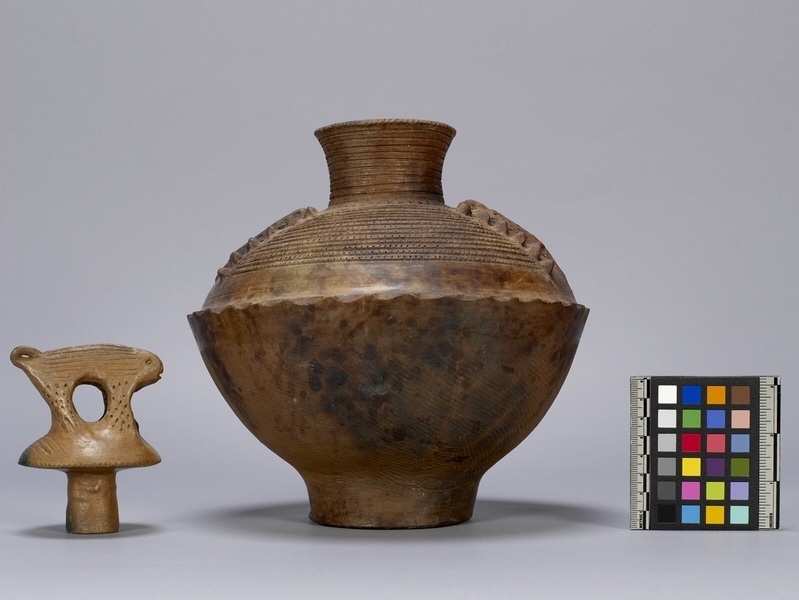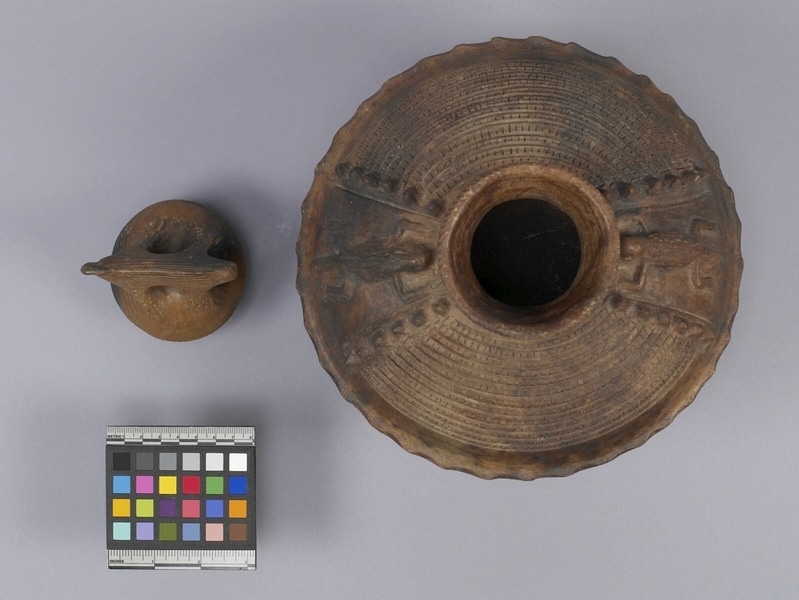Vessel Item Number: K2.297 a-b from the MOA: University of British Columbia



Description
Red clay vessel (part a) with a lid (part b). Pot has two textured panels around the upper sides which consist of thirteen horizontal bands that have incised vertical lines within ending in six knobs at either end. In between these panels, at either side, there is an upward facing lizard in relief. The lid has a chameleon that has incised horizontal lines across its body and impressed dashes along its legs.
History Of Use
Water or palm wine vessels were often elaborately decorated, showcasing popular styles in order to grab attention and to demonstrate the owner’s taste and aesthetic discrimination. These kinds of standardized and common utilitarian objects were often sold ready-made by artists rather than sold as commission-based individual works. Following Cote d’Ivoire’s independence from colonial French rule in 1960, Baule visual culture persisted in the art trade market with the establishment of four major art market centres in Abidjan, Bouaké, Korhogo, and Man. In the last quarter of the 20th century, locally made utilitarian objects were replaced with machine-made objects from outside of villages. They were favoured for their association with money and modernity.
Narrative
Purchased by the collector in Abidjan, although the maker lived near Bouake..
Iconographic Meaning
In Baule works, frequently used motifs of mammals, birds, fish, amphibians, and reptiles are representations of specific proverbs. However, multiple proverbs may be attributed to a single motif; additionally, motifs and their potential meaning are often subject to the intent of the artist and demands of the patron and the meanings are not always universal.
Item History
- Made by Amoin Eku Aya (Maker) in Bouake, Cote d'Ivoire during 1971
- Collected by Deborah Taylor between 1971 and 1972
- Owned by Deborah Taylor before 1972
- Received from Leon & Thea Koerner Foundation (Funding source) and Deborah Taylor (Seller) during 1972
What
- Name
- Vessel
- Identification Number
- K2.297 a-b
- Type of Item
- vessel
- Material
- clay
- Manufacturing Technique
- hand moulded
- Overall
- height 29.5 cm, diameter 22.0 cm
Who
- Culture
- Baule
- Creator
- Amoin Eku Aya (Maker)
- Field Collector
- Deborah Taylor
- Previous Owner
- Deborah Taylor
- Received from
- Leon & Thea Koerner Foundation (Funding source) and Deborah Taylor (Seller)
Where
- Holding Institution
- MOA: University of British Columbia
- Made in
- Bouake, Cote d'Ivoire
When
- Creation Date
- during 1971
- Collection Date
- between 1971 and 1972
- Ownership Date
- before 1972
- Acquisition Date
- during 1972
Other
- Item Classes
- ceramics
- Condition
- good
- Current Location
- Case 98
- Accession Number
- 0200/0005 a-b